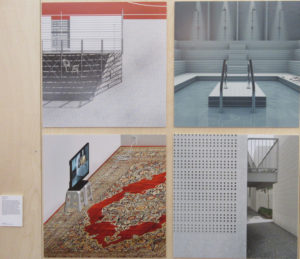post 10 Sustainable Approach to Design
RCA exhibition 2017
The Architecture and Interior Design programmes of the Royal College of Art had ventured out from their premises in Kensington Gore to a disaffected fire station in Vauxhall where it staged its end of the year exhibition. The large hall suited the exhibition installation made of blond wood for the stage and projection room and plywood panels to hang up the projects. The space is let for temporary uses – including the Migration Museum – until it is demolished and rebuilt into yet more residential tower blocks, regardless of the catastrophic fire which destroyed Grenfell tower and claimed many lives in West London.
Concern for the environment
Interestingly, among the 77 architecture and interior design projects of the impeccably presented RCA exhibition there was a striking absence of ‘me-projects’: towers reaching into the sky, utopian fantasies, pseudo-art, etc. Instead, both the architectural and the interior design projects showed considerable regard for their potential users, as well as concerns for the environment. The latter included attempts at more sustainable uses of resources, among them recycled card board housing. For urban space this took the form of increased density.
Concern for users
Socially this approach was expressed in new design for communal living, new ways of conceiving collective workspaces, invigorating the public realm by design, or even design leading to more democratic politics.
Cultural diversity
Most projects paid attention to their cultural and physical context. Looking at the student names, they were a very cosmopolitan group. Quite a number of them located their study design tasks in their respective countries, sometimes trying to establish bridges between the culture of their education with that of their background. Examples are linking interiors of Iranian living with that of the west; new uses of water features in Oman; small in-fill buildings into an existing urban fabric for diverse faiths; reuse of obsolete spaces in Beiruth; and even acupuncture improvements of refugee camps in the Middle East.
Interventions at different urban scales
The projects aimed at a wide range of urban scales ranging from cities as a whole to more intimate local neighbourhood spaces and they addressed both environmental and social aspects in their design interventions. Some students focused on a wide city scale, for example to understand the impact of fracking on Blackpool. Some explored large generic landscapes to guide their bio-diversity interventions toward climatic regeneration. Others sought to regenerate the social diversity of townscapes, for example by preserving and fostering diversity in Soho.
Hope for our planet
The show demonstrated that there is hope for the future of our planet. The ideas and solutions presented by the students at the RCA were thought provoking and indicated that contemporary students from a wide range of backgrounds share concern for a sustainable future and seem to be willing to adapt their design interventions to contribute toward it.
















